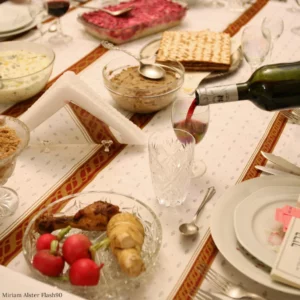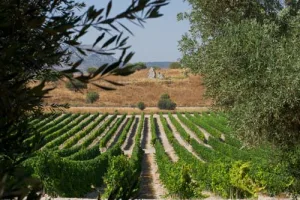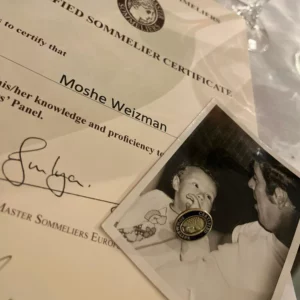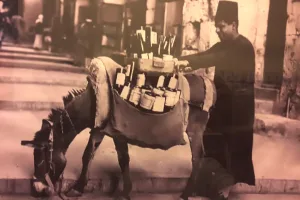Picture the scene. You are sitting at a table overlooking the sea. In front of you are mezze, a wonderful variety of small plates of hors d’oeuvres. A glass of Arak clouded by the addition of water is drunk as an aperitif and then a rosé wine is brought to drink with the meal. You could be in virtually any country in the Eastern Mediterranean or Levant. You could even be in Tel Aviv or Jaffa Port. Mezze, arak, sun and sea are symbols of the region……and rosé is a wine that just reeks of the Mediterranean. It probably symbolizes the atmosphere, climate and food culture as well as any other wine.
I recently was pouring wine at a festival, and it was for me a delight to see the number of people asking for rosé. Also a surprise. We in the wine trade have been talking up rosé for years now. The winery where I worked produced a few but the sales never matched the hype.|
Why the new interest is exciting is because Rosé symbolizes two things for me. First is the idea that wine is for drinking and not always for pontificating about. Wine lovers sometimes forget that. So the simpler wine is a reminder to get back to basics.
Secondly, rosé is a symbol for me of the Mediterranean. One of my perennial campaigns is to explain that Israel is part of the Eastern Mediterranean, and not the Middle East. The Eastern Mediterranean is the region that gave wine culture to the world, whilst the Middle East is more associated with politics, oil, sand and camels. Certainly in marketing wine, anything with the word Mediterranean in it gives you a better chance.
So now we have educated wine people to ask for Rosé with no shame and without a second thought. And why not? It is refreshing, has good acidity, is not too complex or demanding and it goes well with almost everything. I always think Italian food is at its best when rustic and simple. Posh Italian food for me, though very nice, misses the point. Likewise rosé is not generally a wine that merits analysis. It is a wine to drink.
Rosé wines can basically be made in three ways. The easiest and most obvious way is simply by blending red and white wines. Seems logical, except that this method is not used at all, apart from in the making of champagne rosé.
In the second and most commonly used way, the wine receives its hue from skin contact. It is the grape skins of the red varieties that give color. This can be for a matter of hours and a couple of days, depending on the desired depth of color. This can range from pale, watery pink, delicate onion skin to what seems almost like a weak red wine in color (as though a red wine is mixed with a glass of water.) All are rosés, but they can be described as being like white wines made with red grapes. The Americans being good marketers called the pale pink wines ‘blush’ instead of rosé. The French and Moroccans will call it Gris de Gris (literally grey wine).
The third way has more to do with red winemaking than white. To concentrate red wine, sometimes a little of the juice is removed. The off shoot of this manoeuver is a characterful rosé wine. This is called the saignée or bleeding method. The benefit of this method, is that invariably better quality grapes are used.
When buying rosé, be sure only to buy from the last possible vintage. The freshness that is so important is the first thing to go if they are kept too long. The next thing is the color. The beautiful pink color that is so enticing can turn slightly orange if it sits on the shelves too long and becomes oxidized. This is a wine to be serve cold. Put the wine in the fridge for four hours before you need it. Serve it in a white wine glass. It is a good apéritif, is perfect with mezze and cold cuts, but also goes well with fish or poultry. It is also the ideal wine to sit on the balcony and sip during the humid summer and long autumn evenings. It is a mood wine. You have probably heard the slogan ‘match the wine with mood, not with food.’
Rosé in Israel has a chequered history. In the seventies and eighties Grenache Rosé was a big brand. The wine was deep colored, semi dry…or more like verging on semi sweet, but it was very popular. It filled in the gap after the dominance of Carmel Hock and before the rise of Emerald Riesling.
However after that it became a victim of its success. The new wine experts derided rosé as too simple for their new found knowledge and the old Grenache Rosé became a symbol of the poorer standard of winemaking before the quality revolution. When the Golan Heights Winery pioneered the wine revolution, they produced a rosé called by the enchanting name Yarden White Harvest. They then followed this with a Golan Cabernet Blanc and Gamla Rosé Sparkling wine. Unfortunately, the rosé idea was damaged goods and they were eventually dropped one by one.
In the last ten years though, there has been a return to rosé. Suddenly it seemed every winery was making rose to capitalize on this new trend. The Golan Heights Winery have launched a Yarden Rosé Brut, a very high quality pink sparkling wine, which looks here to stay. Many wineries now have rosés and many of the larger wineries have a number of them at different price points. All this goes to show that the style is back in.
The finest rosés produced by some of our best wineries are the Flam Blanc (made from Syrah & Cabernet Franc), Rosé du Castel ( from Merlot, Malbec & Cabernet Franc), Recanati Rosé Barbera & Merlot) and Yatir Rosé (Grenache, Mourvedre & Viognier.)
Less expensive options are the Capsouto Cuvée Eva Rosé (Cinsault, Grenache & Mourvèdre), Carmel 2 Vats Rosé (Grenache, Carignan & Mourvèdre), Galil Mountain Rosé (Sangiovese, Pinot Noir, Barbera & Grenache), Montefiore Rosé (Carignan & Merlot), and Tabor Barbera Rosé (Barbera.) All these are good, refreshing and represent the essence of the Mediterranean. Despite the fact that I list the grape varieties for each wine, the choice of grape variety is not so significant when making rosé.
My favorites in the two groups are the Flam Rosé 2016, delicate fruit, crisp with a steely acidity, and the Tabor Barbera Rosé 2016, which is in a far more fruity, less austere style, but with a refreshing finish. The 2 Vats Rosé represents the best value and the stylish presentation of the Recanati Rosé makes it a gift with added value, but all those mentioned are recommended.
The most well-known rosés worldwide are from France. Rosé is the most popular wine style from Provence and Tavel Rosé from the Rhone and Anjou Rosé from the Loire are also famous. One I have seen in Israel is AIX, Vin de Provence. It is in a Bordeaux style bottle, instead of the traditional Provencal style bottle (tall, with curves and a waist), which is pretty unique to them. The AIX is a blend of Grenache, Syrah, Cinsault and Carignan. Thirty percent of the wine is made by the saignée method. Interesting to taste for this is a region for which rosé is their raison d’être.
More famous is the Miraval, a still remaining joint venture between superstars Angelina Jolie and Brad Pitt. It comes in a squat bottle with a simplistic, but stylish round label. This wine is made from a blend of Cinsault, Grenache and Syrah and the white grape Rolle (aka Vermentino). Maybe if you buy this you are paying for celebrity, but they have given worldwide focus to the wines of Provence and the rosé category in particular.
All of these are bone dry. However if you venture across the Atlantic, you will meet the Californian invention White Zinfandel, a pink blush wine not lacking in sweetness. Arguably the most famous rose is Mateus Rosé, because of its sweetness and of course the bottle, which launched a thousand lamps. Over thirty years ago it was one of the largest selling wine brands in the world.
Now for a story, which is not new, but every so often it needs retelling. Once Baron Rothschild, a wine trade veteran, was asked what his favorite wine was. Don’t forget that this is the family that owns some of the greatest wineries on earth. His eyes glazed as he strove to recall the time and place.” I was 19 years old and we were on the beach. It was the height of summer, the sunset was stunning and the girl was beautiful….as for the wine, I don’t remember what it was, but it was the best wine I have ever tasted.”
A great story, that puts wine in the correct perspective. I like to think the wine he was talking about , might well have been a rosé. It is a style of wine which combines with the mood, matches the occasion and contributes to a feeling of well-being and the quality of life. And yet, we don’t have to talk about it endlessly, comparing the complexities and quoting scores. It releases the wine bore from feeling he has to show off. It is not a wine that needs to be put on a pedestal. Rosé reminds me that wine is something simple, not complicated and can be enjoyed without undue fuss.
Adam Montefiore has been advancing Israeli wines for over 30 years. He is known as the ‘English voice of Israeli wine’. He is the wine writer for the Jerusalem Post. twww.adammontefiore.com



















